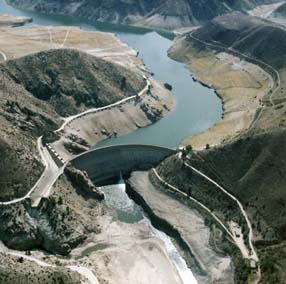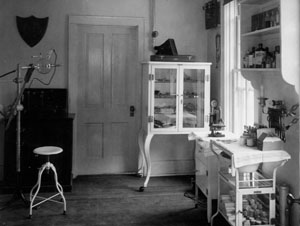
Forty miles east of Boise, near tiny Idaho City, Idaho, population 476, two streams come together to form the main branch of the Boise River. The river originates high in the Sawtooth Range of the Rocky Mountains and flows southwest into a valley so fertile that it is considered one of the best farming regions in the American West. But it was gold, not Idaho potatoes, that brought early American settlement to the Boise River Basin.
In 1862, gold was discovered around the headwaters of the Boise, bringing such a rush of gold seekers that the new town of Idaho City grew to a population of 48,000. Supplying the miners made for lucrative business, and people began to put down roots in the Boise Valley, where irrigation was easy along the bottomlands. Agriculture depended on irrigation, and irrigation depended on diverting water from the Boise River. Arrowrock Dam, the tallest dam in the world when it was completed in 1915, provided the means to store Boise River water so it would be available when needed.
The first right to divert the Boise River for irrigation was granted in 1864, and by the 1870s nearly all of the bottomland along the river was under cultivation. In the early 1880s, eastern capital arrived in the valley through Connecticut native A. D. Foote, who envisioned building a 75-mile-long canal all the way from the Boise to the Snake River on the Idaho-Oregon border. Not only would the canal--the New York Canal--irrigate thousands of acres of new lands, but it also could provide water for placer mines along the Snake. The canal proved enormously expensive to build, and after 16 years of work, only the first 10 miles of the canal had been completed. Even so, as agriculture surpassed mining as Idaho’s economic lifeblood, a series of farming groups took over operation of the canal.
The New York Canal was one of many private commercial canal enterprises attempted in the Boise River valley in the last decades of the century. All experienced difficulties caused by insufficient funding, a lack of engineering know-how to build storage reservoirs, operational costs that consumed anticipated profits, and unresolved water rights legal issues. However, there was sufficient success that by 1900, 102,000 acres were under cultivation, towns were platted throughout the valley, and small businesses such as the creamery in the nearby town of Meridian, and a fruit drying plant near Beatty, were flourishing.
As of 1900, irrigation in the Boise Valley still relied on flood flow. There were no storage reservoirs to hold back springtime flows for use later in the summer. With average precipitation of only 12.1 inches a year, a low-water year could stress a farmer out, especially if the dry years dragged on as they did in 1900, 1901, and 1902. Furthermore, it became increasingly apparent that the Boise River was over-appropriated, and even in wet years the flow was not enough to meet everyone’s needs. What was required to fix the problems was resolution of water rights issues, and construction of large-capacity reservoirs.
“The situation had become so strained,” historian Paul L. Murphy writes, “that irrigators along ditches in the western end of the valley were continually in dispute over the dwindling water supply.” Circumstances culminated in a legal fight dubbed the “Big Water Suit,” which began in 1902, the same year that the U.S. Reclamation Service (today’s Bureau of Reclamation) was created to administer the Reclamation Act of 1902. The act committed the Federal Government to build permanent irrigation works--dams, reservoirs, and canals-–in sixteen arid and semiarid Western states, including Idaho. As Murphy argues, the Big Water Suit, which focused on ways to solve the Boise water rights issues, paved the way for “enthusiastic local acceptance” of the Federal Government’s entrance into local water matters.

Land-owners in the Boise and Payette valleys organized into a water users association, and then petitioned Congress for approval of a Federal irrigation project in those valleys. In 1905, Congress approved construction of the Payette-Boise Project (now simply called the Boise Project). Reclamation purchased the New York Canal and its water rights, and signed water service agreements with other private irrigation companies that in effect incorporated all irrigation companies and their canals on the south side of the Boise River, into the Boise Project. A major portion of the Nation`s requirement for sweet corn seed is grown on the Boise Project. The project also produces large quantities of grain, alfalfa hay, pasture, sugar beets, corn, potatoes, onions, apples, and alfalfa seed. The hay and forage crops support a large number of dairy and beef cattle.
Arrowrock Dam is just one component of the project, which has expanded since its original authorization on March 27, 1905, to comprise five storage dams, two diversion dams, three powerplants, 721 miles of canals, seven pumping plants, 1,323 miles of laterals, and 649 miles of drains. The project furnishes irrigation water to about 390,000 acres in southwestern Idaho and eastern Oregon, assuring Idaho’s place in American agriculture. Today, Idaho produces 30 percent of the nation’s potatoes, 53 percent of its Austrian winter peas, and a fifth of its barley, mint, sugar beets, and wrinkled seed peas.
Arrowrock, a 350-foot-high concrete arch dam, was constructed to store water, which then was diverted into an enlarged and extended New York Canal. The canal transported Boise water to Indian Creek, and then through a second canal to Deer Flat Reservoir, now known as Lake Lowell. After intensive surveys, a site for Arrowrock Dam was selected 22 miles upstream from Boise. Because the only access to the site was an old wagon road unable to handle the construction traffic and heavy loads, Reclamation wanted to build a 17-mile railroad spur from Boise. However, because the Intermountain Railway Company owned a right-of-way near the dam site, Reclamation struck a deal for an easement. Reclamation formed a common carrier to construct the tracks and run the train, while Intermountain leased the track rights. Thus, historian William Joe Simonds writes, “the Boise & Arrowrock Railroad was born,” the Federal Government’s first public railroad, registered on August 22, 1910, as a public carrier in Ada County, Idaho.
With the dam authorized on January 6, 1911, work began on the Arrowrock construction camp, which, at its peak, was home to 1,400 people, including 200 families. More than thirty buildings went up, including cottages and bunkhouses, a hospital, mess hall, hotel, store, post office, and amusement hall operated by the Y.M.C.A. A school, staffed by two teachers, enrolled ninety students.
Before construction on the dam could begin, the river was diverted around the site through a 470-foot-long tunnel. In late February 1912, excavation for the dam foundation began. When workers discovered a lava bench between 20 and 50 feet thick, it had to be removed because lava was not considered a suitable foundation material.

In November 1912, as the first concrete was poured, engineers were just learning that a massive pour of concrete, as it hardens, creates great internal heat and expansion. Engineers worried that subsequent cooling and contraction would create dangerous cracks in the interior of the dam. For this reason, engineers decided to use a mixture of Portland cement and sand in the construction of Arrowrock. The strength of the mixture proved, Simonds writes, “to be only slightly less than that of pure cement after 6 months, and comparable in strength after 1 year.” The sand-cement, however, proved to be highly absorbent, and the consequent freezing and thawing caused deterioration. Between 1935 and 1937, Arrowrock’s downstream face was repaired with a new slab of concrete, and the dam was raised five feet.
Arrowrock was built in three sections. After the second section was completed in December 1913, the contractor sprinted toward completion setting several records for mixing and placing concrete. In April 1913, workers placed 45,700 cubic yards of concrete--believed to be a world record. Then they broke their own record, pouring 51,490 cubic yards that May and 56,520 cubic yards in June. (A cubic yard equals about 202 liquid gallons.)
When the last concrete was poured in November 1915, Arrowrock, at just over 348 feet, was the highest dam in the world and would not be surpassed until Owyhee Dam was completed on the Owyhee River in Oregon in 1932. The dam was dedicated on October 4, 1915, the day that also marked the end of daily service on the Boise & Arrowrock Railroad.
Visit the National Park Service Travel Bureau of Reclamation's Historic Water Projects to learn more about dams and powerplants.
Last updated: January 13, 2017
